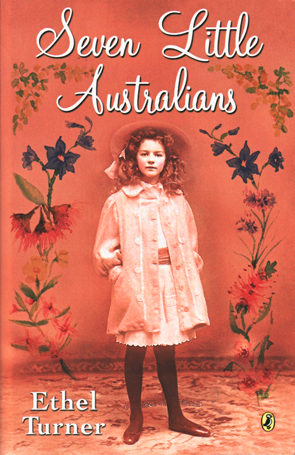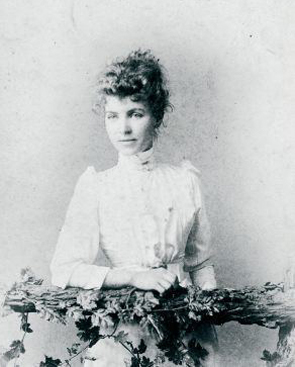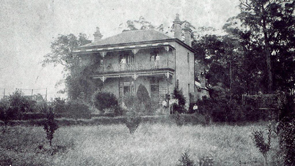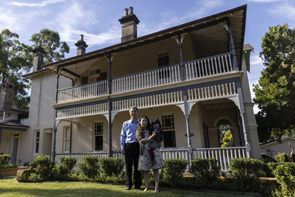This review contains plot spoilers.
Seven Little Australians was first published in 1894 and is now considered an Australian classic. The fact that it has never been out of print since then, that it has been translated into many languages, and has been read in countries as distant from Australia as Sweden, attests to its enduring popularity. That makes it the kind of book, I think, that well-meaning grandparents give to their grandchildren for presents with a hopeful glimmer in their eye. Classics are uncontroversial. Classics are a part of the cultural heritage and that makes them worthy. But while this book will have some appeal to modern children, depending on the child, its style and values might be jarring to some.
This is the story of Captain John Woolcot, his six children from his first marriage (his wife having died four years before) and his second wife, Esther, only twenty years old, with a child of her own to Woolcot, called the General by everyone. Woolcot is an army captain who has little empathy with his children. He employs a somewhat ineffective governess for their education, excepting Pip who goes to a grammar school. From early chapters it is clear he does not hold the same values many modern parents would hold. He is of the old school thinking, that children should be seen and not heard. When Colonel Bryant comes to dinner the children are relegated to a room upstairs. Downstairs the Captain entertains his guests with roasted fowl, which the children can smell, while they are served their usual boring fare. It is only by confronting his father in front of Bryant that Pip manages to shame him into giving him some fowl. And so begins a procession of children heading downstairs for better food. Naturally, the next day they are punished. None of them will go to the pantomime they have been anticipating. Their father tends to punish rather than reward them, and shows them little affection. Often, he uses a strap or horse whip on them. When Helen (also known as Judy) is found to have consumption after walking many miles from her boarding school (to which she was sent as punishment) her chief fear is that when she gets better her father has saved many beatings for her.
Given the mood to re-evaluate older works at the moment, this book won’t be as uncontroversial a present as grandma and grandpa might expect, depending on their way of thinking. While Turner warns us her children are not good, they are distinctly of a Christian mindset and conservative way of thinking, nevertheless. But it is not possible to read the book without feeling a jarring sense that its values are no longer our own. I am not of the mindset for that a book should be banned, but if I was I think it is nowhere close to deserving such a fate, anyway. Characters like Judy, would be appealing to modern readers for her independent spirit. She makes an admirable foil to her father’s unreasonable repression. And Meg’s dilemmas would also be identifiable to many readers. Meg, at sixteen, is struggling to navigate her own awakening sexuality. But just as books have become popular and have endured over time, it is also possible they are of their time, possibly representing a different set of values to those of its modern audience. That can be interesting in itself if the reader is able to contextualise the story.
But part of the problem in reading this book comes from Ethel Turner’s intrusive narrative voice. The opening chapter in which she introduces the family provides a good example. Turner steps into the story from the start, beckoning us to draw closer to the scene of her young characters eating noisily, thereby forming a relationship with the reader with which she attempts to moderate the reader’s reaction to the seven. This is not going to be a tale about good children, we are told, for “Not one of the seven children is really good, for the very excellent reason that Australian children never are.” While children in other countries may be paragons of virtue
they are not the author’s concern and Turner claims to know nothing about them. Modern children will need to understand the context of this story. That it was written when Australia was still part of Great Britain. Australia didn’t become an independent nation until 1901, and during the 1890s the Federation movement gained ground and there was much interest in differentiating an Australian type through literature and art from its English forebears. It is not by accident, I think, that Turner foregrounds a distinct national identity in her title, through the places explicitly named that her children travel to throughout the story, and her attempts to represent through her narrative the dual cultural identity of the time, split as it was between larger cities like Sydney and the bush, that repository of what was considered as the distinct Australian type: the squatter with large landholdings and the stockmen who worked them.
Turner is a controlling narrator, just as Woolcott is a controlling father. She does not shy from moralising or forcing the point of her story. When Meg finds herself walking with a young man at night (through an outlandish set of circumstances – peer pressure, improperly delivered letters and misunderstandings, because she certainly doesn’t understand the significant reputational danger she is placed in) Turner is careful to have her male, Alan, first judge Meg: “It’s all the same as long as it’s a boy, isn’t it” (she was expecting his brother) and then refuse to believe she does not wish to be kissed: “I know you said you did not want to be kissed, but then, girls always say that, don’t they? – even when they expect it most.” But before you think Alan would find himself in trouble in a modern setting by saying this, he then turns on a dime to show he is only teaching Meg a lesson: “…you used to seem such a nice girl”, he says (now battering her self-esteem from another moral position). Meg is distraught and promises, “I’ll never flirt again while I live.” Although later, Meg will give her ribbon to Mr Gillet, a stockman on a country property owned by her step-mother’s parents. But when Mr Gillet drinks too much she decides she will have nothing to do with him. Once again the tables are turned on Meg. Mr Gillet sits Meg down and lectures her, “that the gentlest-looking women are nearly always the hardest” and “it is only women like you, Miss Meg, and angels who can keep to the path always.” Meg must once more capitulate: “Oh, how very horrid I have been – oh oh oh!”
It is not enough that Turner’s story hammers home the point, but that her narrative voice must also catch inattentive readers, to make her point. If you thought Captain Woolcot might be the villain of the piece, you would be wrong. As narrator, Turner says of Australian children that many are “giggling, forward young things who want whipping”. Of Australian girls she says they are like a peach that ripens in a day: in short, they grow up too quickly. Meg is described by the narrator as “a foolish little thing” for falling in love, and when Meg’s shortcomings are revealed it is the 20-year-old Esther who is blamed: “these children were not receiving a mother’s care at her hands.”
Turner’s narrative is judgmental, manipulative and possibly derivative. There is a broad feeling, once you notice it, that Turner is writing a pared-down Australian version of Louisa Alcott’s novel, Little Women. Aldith, who grooms the impressionable Meg and pressures her into seeing boys, gives her authors to read, including Louisa Alcott. There are some broad comparisons to be made with her book and Turner’s. They are both about their societies at an historical point of change: the American civil war; the growing sense of Australian identity and the Federation movement. They both are about a family of children growing up. Turner focusses her story mostly upon Meg and Judy (Bunty, their younger brother, offers mostly comic relief or serves Judy’s story). Turner’s oldest child of the seven is Meg, 16 years old. Alcott’s oldest child is Meg, 16 years old. Beth, the one everyone likes in Little Women, dies from scarlet fever. Judy, the rebellious one who is central to the dynamics of the Woolcot family, develops consumption. Turner kills Judy off, too, although it is done in a bizarre scene with a falling tree. She still gets a lingering death, although the realities of her crushed body are spared us with the ennobling thought of her sacrifice (she saved her youngest brother) and the gorgeous sunset that is a symbol of her purer soul.
What is most disappointing is that while Turner is capable of writing empathetic, even admirable characters (Judy is the most appealing of all with her independence and fighting spirit) she cannot seem to help manipulating our attitudes to them or their situation. As a result there is a strange ambivalent tone to the book, at once casting moral judgment while at the same time extending sympathetic treatment to the characters. There are many appealing qualities to the book and many scenes that are funny or dramatic: much that is, in short, worth a read. But young readers of today will have to navigate Turner’s narrative style and make their own judgments about her characters in the light of their own values.

 RSS Feed
RSS Feed Facebook
Facebook Instagram
Instagram YouTube
YouTube Subscribe to our Newsletter
Subscribe to our Newsletter






No one has commented yet. Be the first!